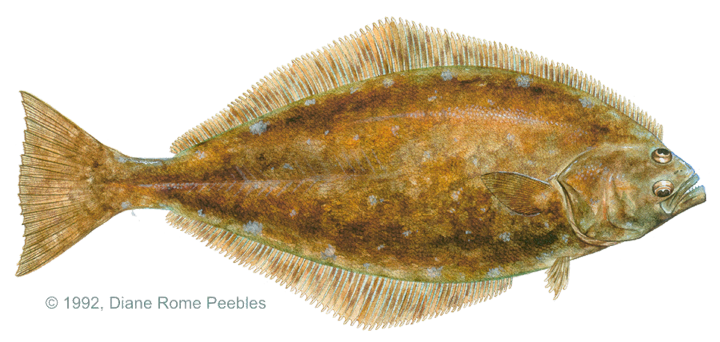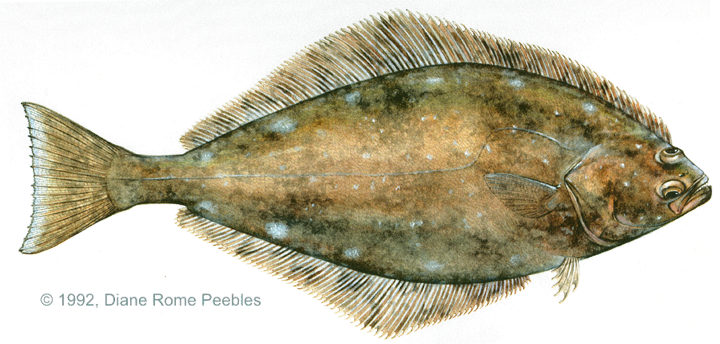Game Fish Identification Reference Guides
Halibut, Atlantic
(Hippoglossus hippoglossus)
(Hippoglossus hippoglossus)

(Linnaeus, 1758); PLEURONECTIDAE FAMILY; also called common halibut, giant halibut, righteye flounder
Inhabits cold and boreal waters of the North Atlantic, including the Barents Sea, Iceland, and Greenland. It is also found in very deep, cold waters as far south as Virginia on the American side and southwest Ireland on the European side. This species does not occur in near freezing polar waters as many people believe, but is replaced there by the Greenland halibut, Reinhardtius hippoglossoides.
The Atlantic halibut is among the largest bony fishes in the sea. The largest known specimen was taken off Sweden and weighed 720 lb (326.6 kg). Halibut weighing 350 lb (158.76 kg) are about 7 8 ft (2 2.5 m) long and 4 ft (1.2 m) wide.
The lateral line, which has a scale count of about 160, arches strongly above the pectoral fin. The teeth are equally well developed in both sides of the jaw. This species is usually pearly white and featureless on the blind side. Some specimens, nicknamed “cherry bellies”, have a reddish tint on the blind side.
They make extensive migrations and interchanges occur between stocks in North America and Iceland, and among stocks in Iceland, the Faeroe Islands and the North Sea.
Atlantic halibut feed in midwater as well as on the bottom. The best fishing method is drift fishing on the bottom with heavy tackle, but they can be caught on fly.
The halibut is a strong fighter and a valuable food fish. The flesh is of good quality and texture
Inhabits cold and boreal waters of the North Atlantic, including the Barents Sea, Iceland, and Greenland. It is also found in very deep, cold waters as far south as Virginia on the American side and southwest Ireland on the European side. This species does not occur in near freezing polar waters as many people believe, but is replaced there by the Greenland halibut, Reinhardtius hippoglossoides.
The Atlantic halibut is among the largest bony fishes in the sea. The largest known specimen was taken off Sweden and weighed 720 lb (326.6 kg). Halibut weighing 350 lb (158.76 kg) are about 7 8 ft (2 2.5 m) long and 4 ft (1.2 m) wide.
The lateral line, which has a scale count of about 160, arches strongly above the pectoral fin. The teeth are equally well developed in both sides of the jaw. This species is usually pearly white and featureless on the blind side. Some specimens, nicknamed “cherry bellies”, have a reddish tint on the blind side.
They make extensive migrations and interchanges occur between stocks in North America and Iceland, and among stocks in Iceland, the Faeroe Islands and the North Sea.
Atlantic halibut feed in midwater as well as on the bottom. The best fishing method is drift fishing on the bottom with heavy tackle, but they can be caught on fly.
The halibut is a strong fighter and a valuable food fish. The flesh is of good quality and texture













